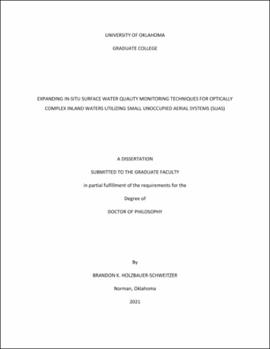| dc.description.abstract | Remote sensing is described as the art and science of interpreting information (e.g., reflectance) collected from a target object (e.g., vegetation) using technology (e.g., satellites, occupied aircraft, and small unoccupied aerial systems (sUAS)) that does not need to contact the object. Remote sensing has been used to evaluate crop health (e.g., agriculture), assess land reclamation efforts (e.g., mining), and, recently to estimate surface water quality (e.g., chlorophyll-a, total suspended solids, and Secchi disk depth). By collecting information contained within the visible electromagnetic spectrum (e.g., visible reflectance), relationships (e.g., linear and nonlinear) have been developed capable of reliably estimating various water quality parameters in large optically deep (bottom substrate does not impact reflectance) waterbodies (ODWs). With the advent and continued improvement of sUAS, waterbodies otherwise too small for satellite applications are becoming more accessible. However, these smaller inland waters can be characterized as optically shallow waters (OSWs) (bottom substrate contributes to measured spectra), complicating the modeling process and accurate retrieval of water quality parameters, which are not well documented. Furthermore, because sUAS platforms, sensors, regulations, and target objects vary considerably across the literature, a desperate need exists to establish a standard operating procedure.
Therefore, the focus of this doctoral research relates to describing optically complex shallow inland waters in terms of the dependency between sUAS-derived multispectral reflectance and various in-situ water quality parameters or optically active constituents (OACs) (e.g., chlorophyll-a, total suspended solids, turbidity, Secchi disk depth, and metal concentrations). Additional examinations included addressing the site-specific nature of surface water quality models by validating models in waters of different geologic origins. An evaluation of the impact operational parameters (e.g., flight speed) on the accuracy of sUAS-derived imagery was also completed. Thus, this dissertation's four chapters provide an in-depth understanding of light and water interactions while demonstrating the environmental applications of sUAS technology for monitoring and evaluating aquatic ecosystems.
Briefly, the results of these efforts revealed: (Chapter 2) approximately 50 percent of the variability in in-situ water quality data could be described by sUAS-derived multispectral reflectance; (Chapter 3) ordinary least squared regression models capable of predicting particulate iron and total lithium, manganese, nickel, lead, sulfur, and zinc concentrations with moderate confidence (R2adj between 0.74 and 0.81) and low error (mean percent difference < 5.13), respectively, were developed; (Chapter 4) more accurate estimations of water quality parameters occurred in ODWs versus OSWs; and (Chapter 5) development of a standard operating procedure for environmental monitoring via sUAS must consider the variety of platforms, sensors, operational limitations and conditions, target objects, and tradeoffs identified. | en_US |

